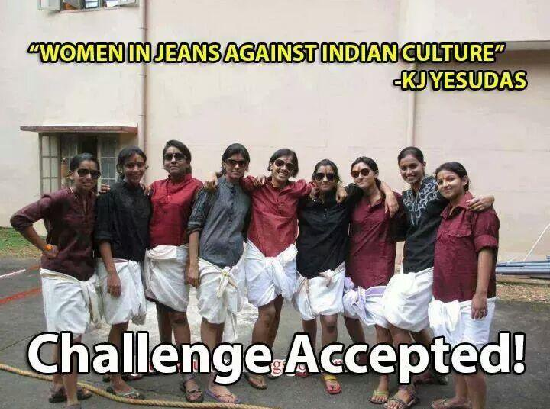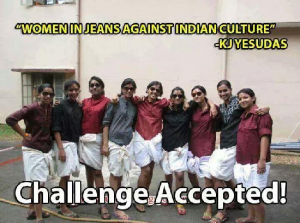
“Everything is funny, if you can laugh at it.”
– Lewis Carroll
Lewis Carroll can be said to have a rights-based perspective as he affirms everyone’s agency to laugh. But not everyone finds everything funny, clearly witnessed by the rising number of defamation suits, speech curtailing legislations, and various groups objecting to the stereotypes that humour banks upon. As feminists, it puts us under an extremely difficult position sometimes: Are there bad jokes? Are there sexist jokes? And if there are, how do we reclaim humour, and does humour have the potential of being something more than being offensive?
I am trying to pitch for a kind of humour that has the potential to create cultures. Some theorists would like to call it Relief Theory, where humour could be used an opportunity to mock the dominant systems, and humour could be the entry point on issues that are generally not talked about. Humour then becomes an opportunity to create one’s own sub-cultures and definitions in the systems. Pop culture uses humour as a base to create references. The poster campaign around Adarsh Balak became a great conversation starter between people from different political lineages. There is a tendency to define humour though we all know that humour is killed by explanations. This gives it a unique beauty of being subjective, leaving space for sense and sensibilities.
There are various types of jokes that tend to float around. The jokes that we hear, perceive, and think about. The jokes we decide to laugh at and the jokes we decide to get offended by. We crack jokes about ourselves, our habits, and then we use jokes as a subversive method to talk about things we can hardly talk about. Humour is the entry point for a lot of situations from where we can talk about forbidden things, and we can subvert and ridicule what oppresses us. Sometimes the ridiculed subject laughs with us and sometimes the subject objects to the very potential of these jokes.
Humour was caught in the controversy of Charlie Hebdo a year back. We fought for our right to humour, we couched it in freedom of expression, and it became a matter of rights for a citizen. The right to satire; the right to criticise; the right to mock a system. It became an aggressive act, an invading act. Greek philosopher Plato in his Republic described amusement leading to laughter as an emotion that leads to other violent emotions and the loss of control over oneself. Plato was not really a big fan of humour and did not see any good potential in humour.
To laugh or not to laugh?
However, can we think of humour in the context of sub-cultures, what if humour becomes the healing act, what if it has the potential to have a discussion about things, and create sub-cultures? Humour by its very nature is transgressive, it works outside the boundaries; can its innate elements be used to include narratives from the margins? Can humour be seen as the entry point for issues in the margin and issues not in ‘focus’? Sexuality in the Indian context has been maturing with varied forms of discussions around it. We see the capitalist markets creating services, we see plenty of channels creating shows around the issue of sex, and we see children secretly talking about it. What we don’t see is an ease in talking about it, we don’t see lightness about the subject, we don’t see the familiarity with which people joke about it, and this is where humour can play an important role.
Humour got more people to talk about the #SaveNetNeutrality debate, with popular comedy group All India Bakchod posting their videos on it. It was humour on the streets in the form of protests/mockery (Shudh Desi Romance), that brought the police and right-wing extremists to confront love on the streets. It was humour of the Pink Chaddi Campaign that brought the Consortium of Pub-Going, Loose and Forward Women to the public front. The online world in the last few years is full of memes and trolls that can sometimes imitate a war zone. Every situation gets simplified to graphics and text, and humour lays the foundation for thoughts to mature. This is where we can think of reclaiming these spaces that are full of sexist, racist, homophobic jokes. We often look towards laws and policies to change perceptions around any issue, mostly focusing on the violence aspect, especially around issues of sexuality. Humour can be that alternative space where we create content around sexuality and make it accessible to everyone. The flooding of the Internet with spoofs, memes, and punch lines increases positive interactions around sexuality. In a lot of incidents, people have taken to humour instead of direct confrontation. For example, when singer Yesudas criticized Malayali girls for wearing jeans, which he said is not appropriate in ‘Indian culture’, the girls, in response, posted pictures of themselves online wearing mundus which were once upon a time worn by women in Kerala.
Similarly, when the Belgian police issued restrictions on movements after the simultaneous attacks in Paris, Beirut and Baghdad in 2015, people posted cats memes all over Twitter and made sure that an atmosphere of fear was not built in their cities.
Can there be feminist jokes?
Is it possible to create stand-up comedy shows which are intersectional and don’t hurt anyone? Enacting jokes about oneself is a safe haven for a lot of us. Be it enacting jokes about one’s own families, one’s own partners, one’s own religion… these have been considered safe for stand-up comedians, but can the artiste tread the intersectionalities of different ‘isms’? Can the self be the critical space for a feminist engagement with humour and sexuality?
Keeping up with the Socratic tradition, I am leaving my thoughts in the form of questions, as answers tend to end conversations. Whether one can laugh or not is the question best left to the audience to decide; but whether we want to engage with humour in a more healing way is a great opportunity for us.
—
I would like to thank Pallavi for her insights.
इस लेख को हिंदी में पढ़ने के लिए यहाँ क्लिक करें।
